Narva: Difference between revisions
Jump to navigation
Jump to search
Knorrepoes (talk | contribs) No edit summary |
Knorrepoes (talk | contribs) No edit summary |
||
| Line 17: | Line 17: | ||
The arms were officially granted on July 24, 1992. | The arms were officially granted on July 24, 1992. | ||
The two fish refer to | The two fish refer to the importance of Narva as a fishing harbour. The three cannon balls symbolise that the city has been an important border town during its history. Narva was a longtime Swedish town on the border with Russia (now the Estonian-Russian border). | ||
The sword and scimitar are based on the arms of Karelia and date from the Swedish time (compare also the arms of [[Finland]]. | The sword and scimitar are based on the arms of Karelia and date from the Swedish time (compare also the arms of [[Finland]]. | ||
Revision as of 18:10, 17 March 2012
| Heraldry of the World Civic heraldry of Estonia |
NARVA
County: Ida-Virumaa
Official blazon:
Origin/meaning :
The arms were officially granted on July 24, 1992.
The two fish refer to the importance of Narva as a fishing harbour. The three cannon balls symbolise that the city has been an important border town during its history. Narva was a longtime Swedish town on the border with Russia (now the Estonian-Russian border).
The sword and scimitar are based on the arms of Karelia and date from the Swedish time (compare also the arms of Finland.
Literature : Image taken from http://www.rk.ee/symb/ and Troels P. Roland
